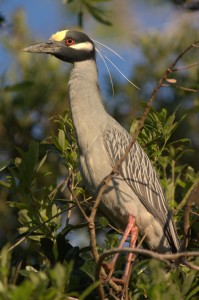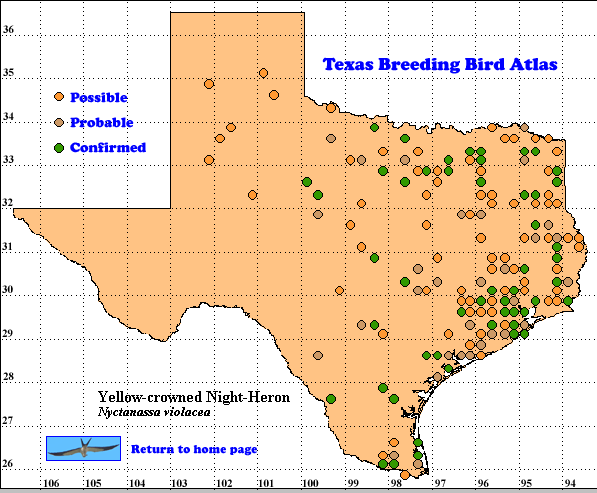Nyctanassa violacea
The Yellow-crowned Night-Heron is a crustacean-feeding specialist whose diet consists mostly of crabs in coastal areas and crayfish in inland areas. Therefore, wetland conditions are especially important, particularly inland.
In Texas, an important influence on waterbird populations is the 20-25 year precipitation cycle (Telfair 2002). Between the early 1960s and late 1980s, there was a significant upward trend in the cycle; since then the trend has begun to decrease (Tom Spencer, Texas Forest Service, pers. comm.). The trend varies regionally and there are intermittent drought years and irregular intervals with pronounced wet/dry springs-summers such as those associated with El Niño/La Niña years and massive slow-moving atmospheric disturbances (Dr. Robert K. Peters, NWS Observer for Tyler, Texas, pers. comm.). Inland wetland habitats are particularly subject to the effects of these trends. Unfortunately, there is a lack of census data about the Yellow-crowned Night-Heron in Texas; so, the possible relationship between its breeding populations and the precipitation cycle is unknown.
Yellow-crowned Night-Herons are cryptically- colored, secretive, and nest in small scattered colonies underneath the canopy of wooded and forested areas. Thus, they cannot be censused by aerial surveys and ground surveys are not feasible. Therefore, their population size is probably larger by at least one order of magnitude than given by estimates (Watts 1995).
DISTRIBUTION: Yellow-crowned Night- Herons are uncommon to locally common summer residents along the Coastal Prairies, throughout the eastern third of the state westward through the central Rolling Plains and eastern Edwards Plateau (Lockwood and Freeman 2004). Most nesting occurs coastally with scattered locations inland east of the 100th meridian with most sites in forested regions (TBBA). The species nested in the South Plains (Midland County) in 1969 (Oberholser 1974).
SEASONAL OCCURRENCE: These herons breed from early March to mid-July. Eggs have been found from March 23 to June 16 with chicks of all ages seen between April 20 and July 7 (Oberholser 1994). Yellow-crowned Night-Herons are casual visitors to the Panhandle and Trans-Pecos regions betweenlate April and early September. They are locally common winter residents along the coast, primarily from Matagorda Bay southward, but rare to casual elsewhere, including the Panhandle (Lockwood and Freeman 2004).BREEDING HABITAT: The Yellow-crowned Night-Heron occasionally nests in low shrubs on coastal barrier and dredge-material (spoil) islands, but, its usual breeding habitat includes forested wetlands along rivers and creeks, swamps, bayous, and urban wooded areas in deeply shaded areas. Nesting is usually in scattered pairs and small colonies up to a few hundred pairs, but, seldom with more than one nest in a tree. Habitat selection is related to the availability of crustaceans, especially crabs in coastal areas and crayfish inland (Watts 1995, Kushlan and Hancock 2005). Small colonies typically begin with a single pair and increase to several pairs over a 4-6 year period and colonies may persist for >20 years. Nest height varies according to the available substrate (Watts 1995). Urban nesting colonies can be considered a nuisance by home owners and zoos.
STATUS: Like the bitterns and Green Heron (Butorides virescens), its cryptic coloration, secretiveness, and scattered small colonies, the Yellow-crowned Night-Heron is so difficult to census that no reliable nesting census data are available. However, North American Breeding Bird Survey data for Texas (Sauer et al. 2005) give annual trends of 10.4% (1966-1979), -6.1% (1980-2005), and -4.7% (1966-2005); thus indicating a declining trend but, this may reflect survey coverage rather than a decreasing number of birds.
Text by Raymond C. Telfair II (2007)
Literature cited.
Kushlan, J. A. and J. A. Hancock. 2005. The herons. Oxford University Press Inc., New York.
Lockwood, M. W. and B. Freeman. 2004. The TOS handbook of Texas birds. Texas A&M. University Press, College Station.
Oberholser, H. C. 1974. The bird life of Texas. University of Texas Press, Austin.
Sauer, J. R., J. E. Hines, and J. Fallon. 2005. The North American Breeding Bird Survey, results/analysis 1966-2005. Version 6.2.2006. USGS Patuxent Wildl. Res. Cnt., Laurel, Maryland. http://www.mbr-pwr.usgs.gov/bbs/bbs.html.
Watts, B. D. 1995. Yellow-crowned Night-Heron (Nyctanassa violacea). In The Birds of North America, No., 161 (A. Poole and F. Gill, eds.). The Birds of North America, Inc., Philadelphia, PA.

